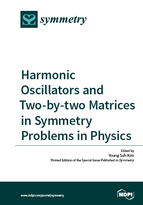Harmonic Oscillators In Modern Physics
A special issue of Symmetry (ISSN 2073-8994).
Deadline for manuscript submissions: closed (29 February 2016) | Viewed by 37250
Special Issue Editor
Interests: physics of the Lorentz group; relativistic quantum mechanics; quantum optics; relativistic harmonic oscillators; internal space-time symmetries; Lorentz covariant quantum mechanics; physical consequences of Einstein’s E=mc2 ; combining the work of Wigner, Dirac, and Feynman
Special Issues, Collections and Topics in MDPI journals
Special Issue Information
Dear Colleagues,
Can you do physics without harmonic oscillators? These oscillators are everywhere in physics, including quantum mechanics and quantum field theory, particle and nuclear physics, atomic and molecular physics, statistical mechanics, condensed matter physics, quantum optics and photonics, entanglement and foundational problems, Wigner functions and the physics of phase space, classical mechanics and electronics, group theory and symmetry problems, quantum dissipation and Feynman's rest of the universe, as well as any new branch of physics you wish to develop.
Since the harmonic oscillator serves as the universal language in physics, it is very useful in picking up new ideas from a branch of physics other than your own. At the same time, it is a very convenient language for explaining your own ideas to others.
Thus, you are encouraged to translate your old papers into the language of harmonic oscillators. It is even better if you could formulate new ideas in this universal language.
We all respect Paul A. M. Dirac. He wanted to explain everything in terms of the oscillators. Did you know that he was able to develop Einstein’s special relativity using harmonic oscillators?
Thus, the purpose this Special Issue is to provide a forum for you to reorganize your earlier works, as well as to present new ideas.
Prof. Dr. Young Suh Kim
Guest Editor
Manuscript Submission Information
Manuscripts should be submitted online at www.mdpi.com by registering and logging in to this website. Once you are registered, click here to go to the submission form. Manuscripts can be submitted until the deadline. All submissions that pass pre-check are peer-reviewed. Accepted papers will be published continuously in the journal (as soon as accepted) and will be listed together on the special issue website. Research articles, review articles as well as short communications are invited. For planned papers, a title and short abstract (about 100 words) can be sent to the Editorial Office for announcement on this website.
Submitted manuscripts should not have been published previously, nor be under consideration for publication elsewhere (except conference proceedings papers). All manuscripts are thoroughly refereed through a single-blind peer-review process. A guide for authors and other relevant information for submission of manuscripts is available on the Instructions for Authors page. Symmetry is an international peer-reviewed open access monthly journal published by MDPI.
Please visit the Instructions for Authors page before submitting a manuscript. The Article Processing Charge (APC) for publication in this open access journal is 2400 CHF (Swiss Francs). Submitted papers should be well formatted and use good English. Authors may use MDPI's English editing service prior to publication or during author revisions.
Keywords
- classical and quantum oscillators
- symmetry problems
- fundamental physics
- applied physics
- frontier physics
- foundations of quantum mechanics






